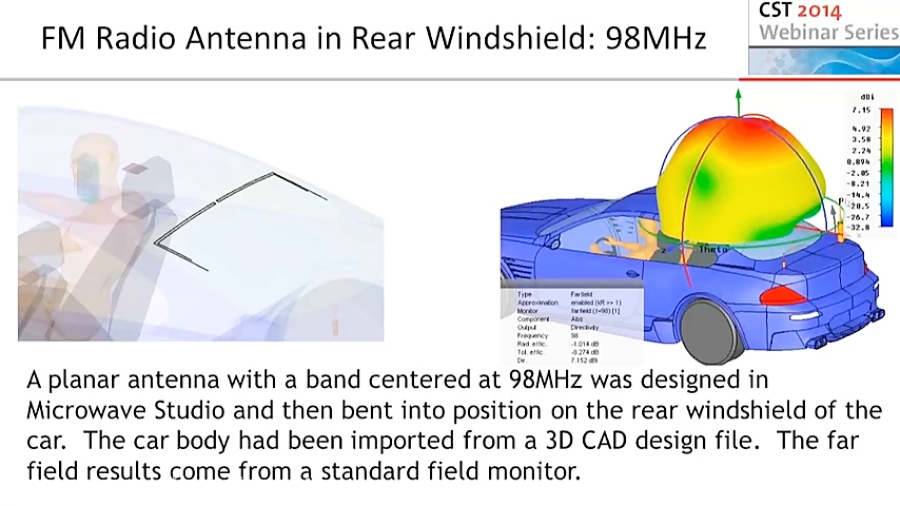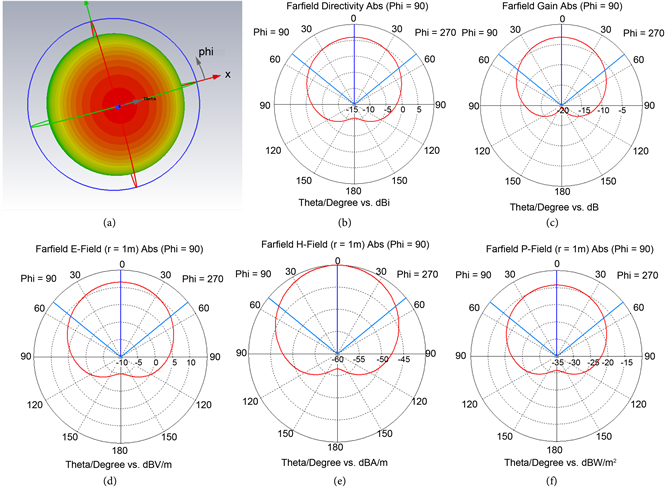

where is the speed of the light, is the relative permittivity of used the substrate ASTRA®MT77. Given the lower cut-off frequency, the width of the opening of the flared edges should satisfy the below equation, respectively. The design equations for the exponentially tapered edge are given by ( 1)–( 3).

and are start and end points of the exponential taper. The exponentially tapered edge of the antenna is defined by the opening rate and the two points (the centre of the chamfer edge with the radius ) and (the centre of the chamfer edge with radius ). The front and back shape contain two symmetric exponentially tapered patches placed on either side of the substrate.
#Cst microwave studio far field trial
The square slots A–D (see Figure 2(c)) are placed on the AVA based upon trial and error method which is considered to be a heuristic approach.Īntenna’s dimensions and electrical parameters.

The final antenna design is presented by the CST Microwave Studio® (CST MWS) model in Figure 1. The final antenna features were achieved with the help of the shape and placement of introduced slots in front and back side of AVA as shown in Figure 2(d). This balun consists of 50 microstrip to parallel plate transmission line, which tapers into a slotline configuration and later feeds the radiating element. As the radiating element of AVA is a balanced structure, hence it was mandatory to create a balun which provide a match between 50 microstrip feed line and the antenna.
#Cst microwave studio far field Patch
The AVA was initially constructed with a square microstrip patch length and width along with a microstrip transmission line mounted on a dielectric substrate as shown in Figure 2(a). The novel shape (see Figure 1) is designed on ASTRA®MT77 substrate from ISOLA with a relative dielectric constant of 3.0 and a loss tangent of 0.0017, respectively. Design and Optimization of Antipodal Vivaldi Antenna 2.1. It is a directional antenna with end-fire characteristics. With increasing interest in UWB as viable radio architecture, the Vivaldi Antenna has attracted interest due to its theoretically infinite bandwidth. More recently, the Vivaldi Antenna has been identified as being suitable for Ultra Wide Band (UWB) applications. The Antipodal Vivaldi Antenna (AVA) is a wideband and symmetric E and H plane that has been used extensively in radar applications, wireless communication applications, and dual polarization applications. used this idea to construct a Vivaldi Antenna and have shown good results over a wide frequency range by maintaining a transition region from three to five wavelengths long distance to avoid a discontinuity between a feed and the radiating regions. To increase the performance of the antenna the slot line was used as a radiation mechanism and paired-strip improves the transition region. Later, the antipodal slot line suggested by Gazit also referred to as symmetric double-sided slot line was constructed with microstrip feed as an input feed. The Vivaldi Antenna was first described and characterized in 1979 by Gibson. The measured prototype antenna provides linear polarization with overall radiation efficiency of more than 90%. The simulated antenna achieved a maximum gain of more than 9 dBi whereas the experimental antenna reached around 7 dBi between the operating frequency range from 1 GHz to 13 GHz. The characteristics of all the antenna parameters are clearly studied and we are successful to achieve closed results between designed as well as experimented Vivaldi Antenna. The results of the desired antenna were simulated through extensive simulations performed in CST Microwave Studio®. Moreover, ISOLA has significantly good electrical and nonelectrical properties as compared with other substrate materials. We have chosen a unique substrate material to develop our novel Antipodal Vivaldi Antenna because most research has been done on commonly used materials like FR4, RT Duroid, etc. We have designed and fabricated the improved structure of Antipodal Vivaldi Antenna with the help of new dielectric substrate ASTRA®MT77 material. This paper introduces an improved shape of Antipodal Vivaldi Antenna from the normal schematic structure which yields a high radiation gain.


 0 kommentar(er)
0 kommentar(er)
